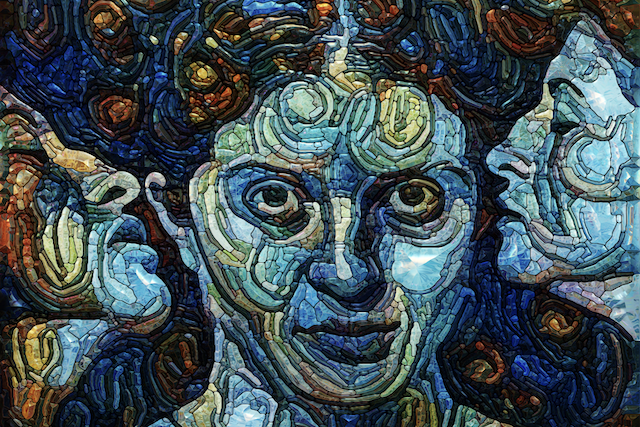The Heart of Chan Buddhism
Chan Buddhism is a painstaking practice of learning nothing, says Gilbert Gutierrez. You can’t become enlightened — you can only embody it. The post The Heart of Chan Buddhism appeared first on Lions Roar.

Chan Buddhism is a painstaking practice of learning nothing, says Gilbert Gutierrez. You can’t become enlightened — you can only embody it.

Photo by Arun Prakash.
When asked “What is Chan?” I’m reminded of how one old Buddhist master once answered the same question: “Ask the lamppost.”
Here’s another Chan story about a master speaking with a young monk. The master says, “I have nothing to teach you.”
The young monk is wide-eyed and stunned. Scratching his head, he asks, “But, Master, if you have nothing to teach me, why am I learning from you?” The master smiles and says, “You are learning from me until you realize I have nothing to teach you.”
To know all the buddhas of the past, present, and future, perceive that all phenomena is created by the mind.
The meaning of Chan Buddhism—and the meaning of Buddhism generally—is beyond words and phrases. It cannot be described. Chan is a practice tradition that puts spiritual authority and knowledge not in written scripture, but in immediate, embodied experience, which is available to anyone, anywhere. Nonetheless, there are still ways we can talk and learn about Chan.
It’s said that Chan originated in India when the Buddha held up a flower, and his disciple Mahakasyapa smiled in response; he was the only one who understood the wordless sermon and could embody it, demonstrate it. Mahakasyapa is recognized as the first patriarch in the Indian lineage of Chan. Following Mahakasyapa, the teachings were passed from person to person, mind to mind. In total, there were twenty-eight Indian patriarchs.
After Buddhism was first introduced in China during the Han dynasty (202 BCE–220 CE), it was viewed as a foreign religion for centuries. Then Chan, a form of Buddhism indigenous to China, began developing in the sixth century. The Chinese word chan is the Sinification of the word dhyana in Sanskrit, which means “contemplative meditation.” The Chan tradition, though, was not special in emphasizing meditation. What distinguished Chan was its emphasis on the embodied realization of awakening or enlightenment, transmitted directly and wordlessly from teacher to student in face-to-face encounters.
Bodhidharma is credited with being the first patriarch, or teacher, of Chan in the Chinese lineage. Hailing from Central Asia or India, he made his way to China where he taught a “special transmission outside of scriptures.” He presented “wall gazing”—that is, meditation while facing the wall of mind—as a way to realize or awaken to one’s inherent buddhanature. This is at once a simplified meditation and a profound practice. Chinese Chan masters coined the term wunian (no thought) to describe it.
Wunian does not mean that the purpose of the practice is to make the mind blank. Such an erroneous take is considered to be “entering the devil’s cave.” Instead, the mind is restored to its proper function and is unmoved by habitual thought patterns, which produce vexations from the three poisons of greed, hatred, and ignorance. So, in Chan meditation, one sits gazing at a wall, using natural awareness of the mind to perceive mental formations, including emotions and sense of self, simply as thoughts—not truths, not states of reality, or states of being—just contingent conceptualizations rising and falling away. One does not try to purge the mind of thoughts but to see them as clouds naturally passing through the mind.
Including Bodhidharma, there were six ancestral founders or original teachers of the Chinese lineage of Chan. Some of these patriarchs’ names might be familiar to you: Dazu Huike, Sengcan, Dayi Daoxin, Daman Hongren, and Huineng (the well-known sixth patriarch of the Platform Sutra). In Chan Buddhism, a lineage of ancestors is listed in order and a record is kept of which teacher has transmitted this unutterable, inconceivable teaching, and to which student(s). Maintaining the lineage and reciting the names of our ancestors is a practice still employed as a way of verifying whether someone is qualified to teach, and as a way of maintaining the integrity of the dharma.
Chan is a branch of Mahayana, a broad group of Buddhist traditions, which first developed in India. After developing in China, Chan was subsequently imported to Japan. There, it was pronounced Zen. Chan also came to be known as Seon in Korea and as Thien in Vietnam. Chan, Zen, Seon, and Thien are related, but they’ve taken on the flavors of the cultures they’re practiced in.
The Chan tradition shares the Mahayana Buddhist belief that the minds of all beings are already buddha mind, so practitioners reason that one cannot practice Chan to become enlightened, only to embody and demonstrate enlightenment. In other words, enlightenment is not something to seek by means of meditation. Enlightenment, rather, is to be realized as a state or condition that has ever been the case—whether you see or not, whether you like it or not! In principle, awakening requires no particular training at all. It’s available right here, right now.
But don’t assume that the Chan Buddhist tradition is without doctrinal beliefs. Chan includes a philosophy, which attempts to verbally approximate the nature of reality. In Chan practice, one makes great effort to distinguish between “conceptual thinking” and “mind.” Think of a Venn diagram in which all conceptions or thoughts are contained in a circle inside a larger and infinite circle of mind. Mind cannot be defined. Indian Buddhists referred to mind as tathata, meaning “thusness.” (Just try to define the term “thusness.”)
The Chan statement of “just this mind is the Buddha” means that there is no other mind apart from one’s ordinary, mundane mind. There is no separate, higher, or “better” buddha mind. Further, Chan practitioners do not confuse consciousness with mind. There is a saying in Chan: “The wise return consciousness to mind; Fools turn mind into consciousness.” This statement, at the heart of Chan, means that all phenomena return to the buddha mind. So, the emphasis in Chan is to clearly view—through mind’s own awareness—that all phenomena, including your regular daily judgments, thoughts, conceptions, emotions, and desires, are “empty.” How does one do it?
Chan uses the huatou and mozhao as its primary meditation methods. Huatou, which literally means “before the word,” involves repeating a meaningless inquiry such as “What is emptiness (wu)?” or “Who is reciting the Buddha’s name?” or “Who is dragging this corpse around?” The purpose is to place the mind’s attention on where the question arises. The method of mozhao, literally “silent illumination,” is just sitting. It uses samadhi (a calm, stabilized mind) and vipassana (insight) to stay in the present moment via awareness of mind. Both of these Chan meditation methods effectively allow the true nature of mind to be realized.
I’d like to offer two Chan statements to help give direction to your practice. The first is: “To know all the buddhas of the past, present, and future, perceive that all phenomena is created by the mind.” The second, which is the actual practice, is to “turn the mind’s eye inward.” This is accomplished by maintaining an awareness of what is arising in mind without allowing unnecessary discriminations to arise. In other words, you notice thoughts arising without judging, evaluating, or attaching to them. Just notice. And as you practice, you may increasingly notice more and more. What’s there to notice? A very good question. See for yourself.
These notes so far begin to answer how to practice Chan, but the question remains: why practice it? The purpose is to carry out the bodhisattva vows. These are the fundamental vows of Chan, and express the practitioner’s resolution to awaken in order to liberate (or awaken) all sentient beings, because with enlightenment comes the understanding that to liberate oneself one must liberate other beings, and to liberate other beings is to liberate oneself. This is reflected not only in Chan scripture but also in the wisdom teachings of Mahayana Buddhism, which preceded Chan.
The Mahayana (greater vehicle) Buddhist tradition emphasizes liberating all sentient beings before oneself. This is seen as a greater goal then the personal achievement of nirvana. Relieving the suffering of all sentient beings is the demonstration of wisdom by way of compassion. For Chan practitioners, the object is to apply right view in all activities. It is said that fundamentally, one sits, walks, eats, works, and sleeps in Chan. Even amidst the tasks of necessary worldly affairs, a Chan practitioner views the world—all phenomenon, including the sense of self—as an illusion or dream. This is the viewing of the world via mind’s own perception.
Some describe Chan as the pointing of a finger at the moon, that is, the practice points a person in the direction of buddha mind. But to really see and experience buddha mind, a Chan practitioner might hone in on this question: Whose finger is pointing? You could say that the moon is watching the finger pointing. All of this, though, is far too much chatter. Confused? Have a cup of tea.

 Astrong
Astrong 
































